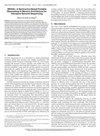探索易失性fpga加速能量收集物联网应用的潜力
IF 1.4
3区 计算机科学
Q4 COMPUTER SCIENCE, HARDWARE & ARCHITECTURE
引用次数: 0
摘要
低功耗易失性fpga (vfpga)自然能够满足物联网设备的复杂处理和灵活性需求。然而,随着物联网设备转向能量收集(EH)以实现自我持续运行,vfpga被忽视了,因为它们在收集的功率下挣扎。它们的易失性SRAM配置存储单元经常丢失数据,导致重配置的代价很高。这些惩罚随着fpga的资源使用而增加,限制了它在EH下的使用。尽管如此,低功耗fpga和能量缓冲系统效率的进步促使我们探索以eh为动力的fpga。因此,我们分析了它们的资源、绩效和重构之间的相互作用;模拟它们在不同EH条件下的运行;并展示如何利用它们达到应用程序和eh相关的阈值。本文章由计算机程序翻译,如有差异,请以英文原文为准。
Exploring Volatile FPGAs Potential for Accelerating Energy-Harvesting IoT Applications
Low-power volatile FPGAs (VFPGAs) naturally meet the intertwined processing and flexibility demands of IoT devices. However, as IoT devices shift toward Energy Harvesting (EH) for self-sustained operation, VFPGAs are overlooked because they struggle under harvested power. Their volatile SRAM configuration memory cells frequently lose their data, causing high reconfiguration penalties. These penalties grow with FPGAs’ resource usage, limiting it under EH. Still, advances in low-power FPGAs and energy-buffering systems’ efficiency motivate us to explore EH-powered FPGAs. Thus, we analyze the interplay of their resources, performance, and reconfiguration; simulate their operation under different EH conditions; and show how they can be utilized up to an application- and EH-dependent threshold.
求助全文
通过发布文献求助,成功后即可免费获取论文全文。
去求助
来源期刊

IEEE Computer Architecture Letters
COMPUTER SCIENCE, HARDWARE & ARCHITECTURE-
CiteScore
4.60
自引率
4.30%
发文量
29
期刊介绍:
IEEE Computer Architecture Letters is a rigorously peer-reviewed forum for publishing early, high-impact results in the areas of uni- and multiprocessor computer systems, computer architecture, microarchitecture, workload characterization, performance evaluation and simulation techniques, and power-aware computing. Submissions are welcomed on any topic in computer architecture, especially but not limited to: microprocessor and multiprocessor systems, microarchitecture and ILP processors, workload characterization, performance evaluation and simulation techniques, compiler-hardware and operating system-hardware interactions, interconnect architectures, memory and cache systems, power and thermal issues at the architecture level, I/O architectures and techniques, independent validation of previously published results, analysis of unsuccessful techniques, domain-specific processor architectures (e.g., embedded, graphics, network, etc.), real-time and high-availability architectures, reconfigurable systems.
 求助内容:
求助内容: 应助结果提醒方式:
应助结果提醒方式:


